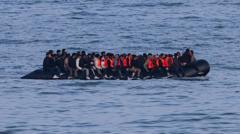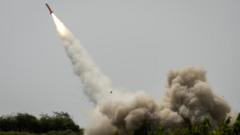In light of rising fears regarding Russian aggression, Vilnius has introduced a comprehensive evacuation plan for its 540,000 residents, detailing protocols for potential military conflict and other emergencies.
Vilnius Develops Evacuation Strategy Amid Growing Regional Tensions

Vilnius Develops Evacuation Strategy Amid Growing Regional Tensions
The Lithuanian capital's new evacuation plan addresses potential threats from Russian military action, outlining procedures to safeguard residents.
Officials in Vilnius, the capital of Lithuania, have released a detailed evacuation strategy designed to protect the city’s residents in the event of an invasion. This plan outlines how the city’s 540,000 inhabitants would be directed to evacuate should the situation escalate to a point where enemy forces threaten to overrun the area. The announcement comes amidst increasing concerns about Russia's military assertiveness in Eastern Europe, particularly following the ongoing full-scale invasion of Ukraine.
Lithuania, alongside its Baltic neighbors Estonia and Latvia, has long expressed apprehension regarding potential Russian aggression and has significantly bolstered its defense capabilities over recent years. Vilnius is strategically located near the 679-km (422-mile) border with Belarus, a key Russian ally that has housed thousands of Russian troops and was instrumental in a previous failed attempt to capture the Ukrainian capital, Kyiv.
Being a NATO member, Lithuania also shares proximity to Kaliningrad, which is a heavily militarized Russian exclave on the Baltic Sea. The newly revealed evacuation plan identifies 150 escape routes from Vilnius and assigns each neighborhood specific exit points, as reported by the Lithuanian public broadcaster, LRT.
In the event of an evacuation, residents would receive alerts via SMS and siren warnings, with a specialized app currently under development to further facilitate communication. Additionally, the plan suggests enhancements to transportation infrastructure, including the expansion of key roads and a bridge to ensure a swift and safe evacuation process.
Vilnius Mayor Valdas Benkunskas emphasized that this evacuation framework would only be enacted as a final measure if military defenses were ineffective. He reassured the public that the unveiling of the evacuation plan should not incite panic, indicating that it does not suggest an immediate or escalating threat.
The plan draws lessons from Ukraine's resilience in the early stages of Russia's invasion and, although primarily focused on potential military threats, it is adaptable for use in natural disasters, nuclear emergencies, or significant infrastructural failures.
Lithuania, which regained independence from the Soviet Union in 1990, has fostered closer ties with Western Europe, including joining the European Union. The country has persistently advocated for Ukraine and cautioned against the Kremlin's colonial ambitions threatening the region.
In a related context, Belarus and Russia are set to conduct large-scale military exercises in September, a move that could place additional troops near Lithuania's borders, raising alarms about regional security vulnerabilities. Military analysts continue to regard the Suwałki gap—a narrow corridor along Lithuania's frontier— as a potential weak point in NATO’s collective defense strategy that, if seized by Russian forces, could sever critical land connections linking Poland to Lithuania and the other Baltic states.




















